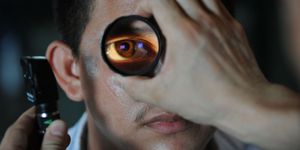Detecting tumors from the shear waves emitted by song
Will a singing test be the way the doctors of the future monitor thyroid health? According to a collaboration of researchers from Université de Tours, Centre Hospitalier Universitaire de Dijon-Bourgogne, and Université Bourgogne Franche-Comté, singing offers a non-invasive technique for screening for thyroid cancer. The technique is described in the journal Applied Physics Letters.
Current detection methods are invasive and inaccurate, detecting only approximately 5% of cancers. "Developing noninvasive methods would reduce the stress of patients during their medical exams," said study author Steve Beuve, who notes that thyroid tumors are most common in children and younger women. "Having to sing during a medical exam can perhaps help release some of the nervous tension even more."

The collaborators report that it is possible to use ultrasound imaging to measure the vibrations that are emitted when we sing. Specific sound waves called shear waves that go through the tissue near the vocal tract will accelerate in the presence of a tumor, due to the way that the tumor changes the tissue.
"The propagation of shear waves gives us information about mechanical properties of soft tissues," Beuve explains, saying that tissue elasticity increases when there is a tumor. The scientists are referring to their technique as vocal passive elastography (V-PE), and stems off from a technique that is actually used in seismology to measure shear waves in the earth.
So, what notes do you have to hit? The researchers say that a patient would need to sing and maintain an eeee sound at 150 hertz, roughly the frequency of D3. The test is non-invasive and does require equipment besides an ultrasound scanner.
The team says that they hope to continue investigating the potential of V-PE in order to see if it is possible to use the technique to detect tumors in other areas, like the brain. "We want to cooperate with physicians to propose protocols to verify the relevance of elasticity as a biomarker of pathogens," commented Beuve.
Sources: Applied Physics Letters, Eureka Alert








